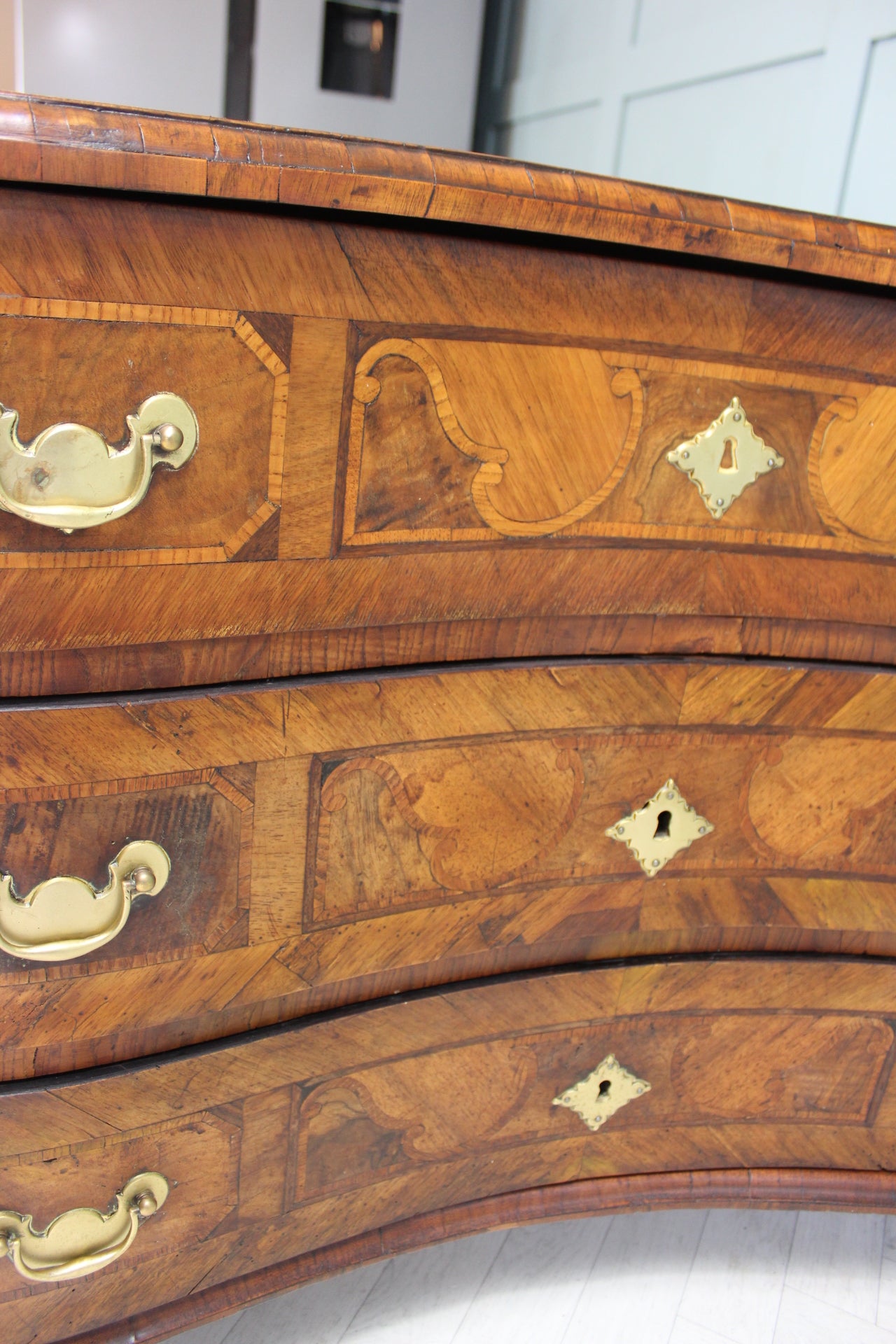18th Century Baroque Chest of Drawers
- Regular price
- £7,900.00
- Sale price
- £7,900.00
- Regular price
























18th-Century Austrian Baroque Chest of Drawers, Circa 1760
Its subtle blend of bold Baroque structure and early Rococo refinement suggests it was created during a period of stylistic transition, possibly for a noble household influenced by the Viennese court. Now revived with care and reverence, this piece offers not just storage but a slice of 18th-century European history — perfect for both collectors and curated interiors.
- Period: Baroque
- Great Colour and Patina
- Date: Circa 1760
- Material: Fruitwood and Walnut
-
Condition:
- Original inlays have been replaced in some areas.
- Evidence of historical wormholes, consistent with its age.
- Provenance: Originally from a Cornish farmhouse.
- Measurements: height 78cm, depth 52 cm, Width 103 cm
This 18th-century Austrian Baroque chest of drawers, made around 1760, reflects the exceptional artistry of its time. Crafted from walnut and accented with fruitwood, it features intricate inlays and marquetry on the top. The design includes three curved drawers with original brass handles and escutcheons, which complement the wood’s warm tones.
Supported by bun feet, this chest combines elegance with functionality. Its flowing lines and detailed Baroque style make it a striking addition to any space. The rich patina and warm colours enhance its timeless appeal.
Key Features of Austrian Baroque Chests of Drawers
In the mid-18th century, Austrian craftsmen embraced the grandeur of Baroque furniture. These pieces were often commissioned by the aristocracy to showcase wealth and refined taste. Made from premium woods, they featured elaborate inlays and marquetry.
1. Design and Craftsmanship
- Graceful Curves: These chests often had serpentine or bombe shapes, with curved fronts and sides. The following lines created a sense of movement and drama.
- Detailed Inlays: Artisans used walnut, maple, and fruitwood to create floral motifs, scrolls, or geometric patterns. These designs highlighted their exceptional skill.
- Elegant Brass Fittings: Handles and keyhole escutcheons were made from cast brass, adding a refined, luxurious touch.
2. Cultural and Historical Significance
- Habsburg Patronage: The Habsburg court in Vienna heavily influenced Baroque furniture. Palaces and noble homes featured these opulent pieces.
- Religious Artistry: The Catholic Church also shaped Baroque designs. Religious institutions commissioned furniture that echoed the grandeur of church architecture.
- Austrian Aesthetic: Austrian Baroque pieces balanced grandeur with harmony. They were less ornate than French Rococo but equally refined.
3. Transition to Rococo
By the 1760s, Baroque furniture began to incorporate Rococo elements. Softer curves, lighter wood tones, and delicate inlays became popular. Transitional designs, like this chest, blended the boldness of Baroque with the elegance of Rococo.
Conclusion
Austrian Baroque chests of drawers from the 18th century represent masterful craftsmanship. Their graceful lines, detailed inlays, and historical significance make them timeless treasures. These pieces bridge the boldness of Baroque with the delicate charm of Rococo, making them ideal for collectors and enthusiasts.
Dimensions
Height 78 cm
Width 103 cm
Depth 52 cm
🔎 Provenance Story
This exceptional Austrian Baroque chest of drawers was discovered in a historic Cornish farmhouse, where it had been a fixture for generations — a rare find that blends central European craftsmanship with British domestic heritage. Passed down through the same family line since the early 20th century, it was originally acquired by a retired naval officer who had developed a keen eye for continental antiques during his postings across Europe.
The chest’s journey from 18th-century Austria to rural Cornwall is a testament to its enduring appeal. Though the original marquetry in some areas has been sensitively replaced over the years, its gracefully curved form, hand-cut inlays, and mellowed fruitwood panels retain the spirit of its Baroque origins. The original brass escutcheons and bun feet remain intact — elegant details that signal both aristocratic lineage and artisanal precision.
UK mainland shipping £80
Contact us if you require high-resolution images, or we can arrange mutually convenient virtual viewing.
For your peace of mind, we offer 21 days of returns- The buyer pays return shipping
🚚 Delivery & Viewing – Sussex Based:
Available to view in Sussex
Local delivery: Sussex, Kent, Surrey, London
UK-wide delivery can be arranged – get in touch for a quote
Worldwide shipping available – Contact us for international rates
Customer support – We are happy to assist with combined shipping, special requests, or custom delivery options
Interior designers, designing your next project, we are happy to hold or reserve items for 14 days.


























